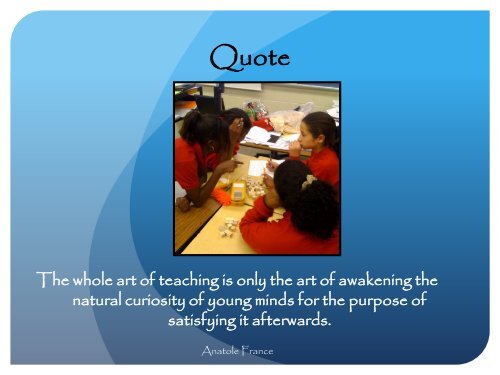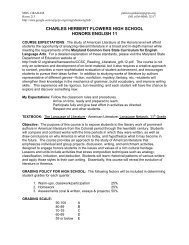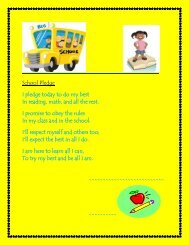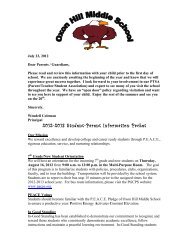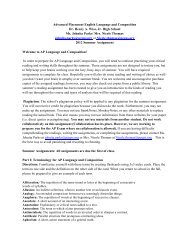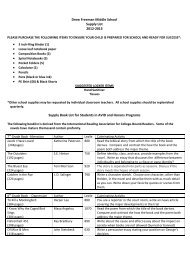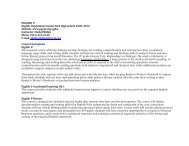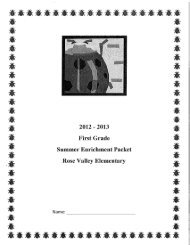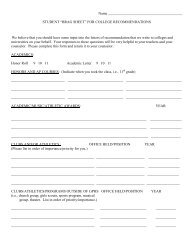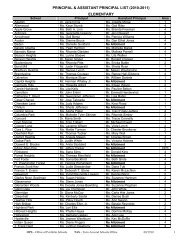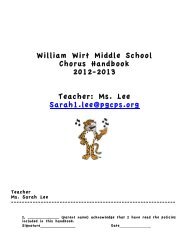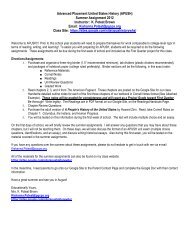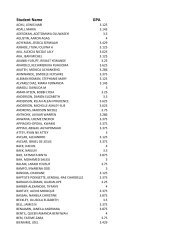The Framework for Teaching - Prince George's County Public ...
The Framework for Teaching - Prince George's County Public ...
The Framework for Teaching - Prince George's County Public ...
Create successful ePaper yourself
Turn your PDF publications into a flip-book with our unique Google optimized e-Paper software.
Quote<br />
<strong>The</strong> whole art of teaching is only the art of awakening the<br />
natural curiosity of young minds <strong>for</strong> the purpose of<br />
satisfying it afterwards.<br />
Anatole France
Introduction to<br />
<strong>The</strong> <strong>Framework</strong> <strong>for</strong><br />
<strong>Teaching</strong> Year 1<br />
<strong>Prince</strong> George’s <strong>County</strong> <strong>Public</strong> Schools 2012<br />
Presenter:
Workshop Objectives<br />
• Overview of the FFT<br />
• Build an initial familiarity with the FFT<br />
• Become familiar with the 8 essential Components<br />
• Review the Teacher Evaluation Model<br />
• Collaborate with Colleagues<br />
<strong>The</strong> <strong>Framework</strong> <strong>for</strong> <strong>Teaching</strong> Charlotte Danielson
Agenda<br />
PART 1<br />
• Establishing the Norms<br />
• Review of the <strong>Framework</strong> <strong>for</strong> <strong>Teaching</strong><br />
• Review of the domains, components, and elements<br />
• Wisdom of Practice<br />
• Memorable Moment - Domain 2<br />
• Signers of the Declaration of Independence - Domain 3<br />
• Artifacts - Domains 1 & 4<br />
PART 2<br />
• Teacher Evaluation Process<br />
• Debrief<br />
• Questions and answers<br />
• Reflection<br />
<strong>The</strong> <strong>Framework</strong> <strong>for</strong> <strong>Teaching</strong> Charlotte Danielson
Let’s Establish the NORMS
P.E.M.D.A.S.<br />
<strong>The</strong> Order of Operations<br />
You have two minutes to use the<br />
letters from P.E.M.D.A.S. to<br />
create the norms <strong>for</strong> today's<br />
workshop.
1 59<br />
58<br />
57<br />
56<br />
55<br />
54<br />
53<br />
52<br />
51<br />
50<br />
49<br />
48<br />
47<br />
46<br />
45<br />
44<br />
43<br />
42<br />
41<br />
40<br />
39<br />
38<br />
37<br />
36<br />
35<br />
34<br />
33<br />
32<br />
31<br />
30<br />
29<br />
28<br />
27<br />
26<br />
25<br />
24<br />
23<br />
22<br />
21<br />
20<br />
19<br />
18<br />
17<br />
16<br />
15<br />
14<br />
13<br />
12<br />
11<br />
10<br />
09<br />
08<br />
07<br />
06<br />
05<br />
04<br />
03<br />
02<br />
01<br />
00<br />
P.E.M.D.A.S.
59<br />
58<br />
57<br />
56<br />
55<br />
54<br />
53<br />
52<br />
51<br />
50<br />
49<br />
48<br />
47<br />
46<br />
45<br />
44<br />
43<br />
42<br />
41<br />
40<br />
39<br />
38<br />
37<br />
36<br />
35<br />
34<br />
33<br />
32<br />
31<br />
30<br />
29<br />
28<br />
27<br />
26<br />
25<br />
24<br />
23<br />
22<br />
21<br />
20<br />
19<br />
18<br />
17<br />
16<br />
15<br />
14<br />
13<br />
12<br />
11<br />
10<br />
09<br />
08<br />
07<br />
06<br />
05<br />
04<br />
03<br />
02<br />
01<br />
00<br />
P.E.M.D.A.S.
P.E.M.D.A.S.<br />
Participate fully, (put phones on vibrate)<br />
Exchange Ideas<br />
Make an Ef<strong>for</strong>t to Listen<br />
Dialogue equally, do your best<br />
Ask Questions, A+ Attitude<br />
Share your insight and support each other, self monitor, self reflect<br />
(sidebar conversations!)
P.E.M.D.A.S.<br />
Expectation<br />
Please Engage in Meaningful<br />
Discussion with Active<br />
Self-reflection!
P.E.M.D.A.S.<br />
Professionally<br />
Empower and<br />
Maximize the<br />
Development and<br />
Achievement of all<br />
Students!<br />
Charge
Set Your Appointments
Set Your Appointments<br />
• You have 2 minutes to circulate<br />
and set appointments with your<br />
colleagues.<br />
• You must set appointments <strong>for</strong> all<br />
even numbers.
Educational Setting
5 Minute Quick Write<br />
<strong>The</strong> Wisdom of Practice<br />
If you were to walk into a classroom,<br />
what might you see or hear there<br />
(from the students as well as the<br />
teacher) that would cause you to<br />
think that you were in the presence<br />
of an expert<br />
What would make you think: “Oh,<br />
this is good; if I had a child this age,<br />
this is the class I would hope <strong>for</strong>.”<br />
Record at least six characteristics.<br />
5
5 Minute Quick Write<br />
<strong>The</strong> Wisdom of Practice<br />
If you were to walk into a classroom,<br />
what might you see or hear there<br />
(from the students as well as the<br />
teacher) that would cause you to think<br />
that you were in the presence of an<br />
expert<br />
What would make you think: “Oh, this<br />
is good; if I had a child this age, this is<br />
the class I would hope <strong>for</strong>.” Record at<br />
least six characteristics.<br />
4 59 58 57 56 55 54 53 52 51 50 49 48 47 46 45 44 43 42 41 40 39 38 37 36 35 34 33 32 31 30 29 28 27 26 25 24 23 22 21 20 19 18 17 16 15 14 13 12 11 10 09 08 07 06 05 04 03 02 01 00
5 Minute Quick Write<br />
<strong>The</strong> Wisdom of Practice<br />
If you were to walk into a classroom,<br />
what might you see or hear there<br />
(from the students as well as the<br />
teacher) that would cause you to think<br />
that you were in the presence of an<br />
expert<br />
What would make you think: “Oh, this<br />
is good; if I had a child this age, this is<br />
the class I would hope <strong>for</strong>.” Record at<br />
least six characteristics.<br />
3 59 58 57 56 55 54 53 52 51 50 49 48 47 46 45 44 43 42 41 40 39 38 37 36 35 34 33 32 31 30 29 28 27 26 25 24 23 22 21 20 19 18 17 16 15 14 13 12 11 10 09 08 07 06 05 04 03 02 01 00
5 Minute Quick Write<br />
<strong>The</strong> Wisdom of Practice<br />
If you were to walk into a classroom,<br />
what might you see or hear there<br />
(from the students as well as the<br />
teacher) that would cause you to think<br />
that you were in the presence of an<br />
expert<br />
What would make you think: “Oh, this<br />
is good; if I had a child this age, this is<br />
the class I would hope <strong>for</strong>.” Record at<br />
least six characteristics.<br />
2 59 58 57 56 55 54 53 52 51 50 49 48 47 46 45 44 43 42 41 40 39 38 37 36 35 34 33 32 31 30 29 28 27 26 25 24 23 22 21 20 19 18 17 16 15 14 13 12 11 10 09 08 07 06 05 04 03 02 01 00
5 Minute Quick Write<br />
<strong>The</strong> Wisdom of Practice<br />
If you were to walk into a classroom,<br />
what might you see or hear there<br />
(from the students as well as the<br />
teacher) that would cause you to think<br />
that you were in the presence of an<br />
expert<br />
What would make you think: “Oh, this<br />
is good; if I had a child this age, this is<br />
the class I would hope <strong>for</strong>.” Record at<br />
least six characteristics.<br />
1 59 58 57 56 55 54 53 52 51 50 49 48 47 46 45 44 43 42 41 40 39 38 37 36 35 34 33 32 31 30 29 28 27 26 25 24 23 22 21 20 19 18 17 16 15 14 13 12 11 10 09 08 07 06 05 04 03 02 01 00
5 Minute Quick Write<br />
<strong>The</strong> Wisdom of Practice<br />
If you were to walk into a classroom,<br />
what might you see or hear there<br />
(from the students as well as the<br />
teacher) that would cause you to think<br />
that you were in the presence of an<br />
expert<br />
What would make you think: “Oh, this<br />
is good; if I had a child this age, this is<br />
the class I would hope <strong>for</strong>.” Record at<br />
least six characteristics.<br />
59 58 57 56 55 54 53 52 51 50 49 48 47 46 45 44 43 42 41 40 39 38 37 36 35 34 33 32 31 30 29 28 27 26 25 24 23 22 21 20 19 18 17 16 15 14 13 12 11 10 09 08 07 06 05 04 03 02 01 00
2 minute Turn and Talk<br />
• Share your characteristics with the group, combine<br />
those that are similar.
Time Left …<br />
Turn and Talk<br />
1 59 58 57 56 55 54 53 52 51 50 49 48 47 46 45 44 43 42 41 40 39 38 37 36 35 34 33 32 31 30 29 28 27 26 25 24 23 22 21 20 19 18 17 16 15 14 13 12 11 10 09 08 07 06 05 04 03 02 01 00<br />
• Share your characteristics with the group, combine<br />
those that are similar.
Time Left …<br />
Turn and Talk<br />
59 58 57 56 55 54 53 52 51 50 49 48 47 46 45 44 43 42 41 40 39 38 37 36 35 34 33 32 31 30 29 28 27 26 25 24 23 22 21 20 19 18 17 16 15 14 13 12 11 10 09 08 07 06 05 04 03 02 01 00<br />
• Share your characteristics with the group, combine<br />
those that are similar.
2 Minute Popcorn Out
1 59<br />
58<br />
57<br />
56<br />
55<br />
54<br />
53<br />
52<br />
51<br />
50<br />
49<br />
48<br />
47<br />
46<br />
45<br />
44<br />
43<br />
42<br />
41<br />
40<br />
39<br />
38<br />
37<br />
36<br />
35<br />
34<br />
33<br />
32<br />
31<br />
30<br />
29<br />
28<br />
27<br />
26<br />
25<br />
24<br />
23<br />
22<br />
21<br />
20<br />
19<br />
18<br />
17<br />
16<br />
15<br />
14<br />
13<br />
12<br />
11<br />
10<br />
09<br />
08<br />
07<br />
06<br />
05<br />
04<br />
03<br />
02<br />
01<br />
00<br />
Time Left …<br />
Popcorn Out
59<br />
58<br />
57<br />
56<br />
55<br />
54<br />
53<br />
52<br />
51<br />
50<br />
49<br />
48<br />
47<br />
46<br />
45<br />
44<br />
43<br />
42<br />
41<br />
40<br />
39<br />
38<br />
37<br />
36<br />
35<br />
34<br />
33<br />
32<br />
31<br />
30<br />
29<br />
28<br />
27<br />
26<br />
25<br />
24<br />
23<br />
22<br />
21<br />
20<br />
19<br />
18<br />
17<br />
16<br />
15<br />
14<br />
13<br />
12<br />
11<br />
10<br />
09<br />
08<br />
07<br />
06<br />
05<br />
04<br />
03<br />
02<br />
01<br />
00<br />
Time Left …<br />
Popcorn Out
<strong>Framework</strong> <strong>for</strong> <strong>Teaching</strong><br />
Organization<br />
Domains<br />
(1, 2, 3, and 4)<br />
Components<br />
(8 Essentials)<br />
Elements<br />
(26)<br />
See page 3 and 4
<strong>The</strong> Domains<br />
1: Planning and Preparation<br />
2: <strong>The</strong> Classroom Environment<br />
3: Instruction<br />
4: Professional Responsibilities<br />
<strong>The</strong> <strong>Framework</strong> <strong>for</strong> <strong>Teaching</strong> Charlotte Danielson
<strong>The</strong> <strong>Framework</strong> <strong>for</strong> <strong>Teaching</strong><br />
Domain 1<br />
Planning and Preparation<br />
•Demonstrating Knowledge of Content<br />
and Pedagogy<br />
•Demonstrating Knowledge of Students<br />
•Setting Instructional Outcomes<br />
•Demonstrating Knowledge of Resources<br />
•Designing Coherent Instruction<br />
•Designing Student Assessments<br />
Domain 4<br />
Professional Responsibilities<br />
•Reflecting on <strong>Teaching</strong><br />
•Maintaining Accurate Records<br />
•Communicating with Families<br />
•Participating in a Professional<br />
Community<br />
•Growing and Developing Professionally<br />
•Showing Professionalism<br />
Domain 2<br />
<strong>The</strong> Classroom Environment<br />
•Creating an Environment of Respect<br />
and Rapport<br />
•Establishing a Culture <strong>for</strong> Learning<br />
•Managing Classroom Procedures<br />
•Managing Student Behavior<br />
•Organizing Physical Space<br />
Domain 3<br />
Instruction<br />
•Communicating With Students<br />
•Using Questioning and Discussion<br />
•Techniques<br />
•Engaging Students in Learning<br />
•Using Assessment in Instruction<br />
•Demonstrating Flexibility and<br />
Responsiveness<br />
<strong>The</strong> <strong>Framework</strong> <strong>for</strong> <strong>Teaching</strong> Charlotte Danielson
Domain 1: Planning and Preparation<br />
a) Demonstrating Knowledge of Content and<br />
Pedagogy<br />
b) Demonstrating Knowledge of Students<br />
c) Setting Instructional Outcomes<br />
d) Demonstrating Knowledge of Resources<br />
e) Designing Coherent Instruction<br />
f) Designing Student Assessment<br />
<strong>The</strong> <strong>Framework</strong> <strong>for</strong> <strong>Teaching</strong> Charlotte Danielson
Domain 1: Planning and Preparation<br />
a) Demonstrating Knowledge of Content and<br />
Pedagogy<br />
b) Demonstrating Knowledge of Students<br />
c) Setting Instructional Outcomes<br />
d) Demonstrating Knowledge of Resources<br />
e) Designing Coherent Instruction<br />
f) Designing Student Assessment<br />
<strong>The</strong> <strong>Framework</strong> <strong>for</strong> <strong>Teaching</strong> Charlotte Danielson
Domain 2: <strong>The</strong> Classroom<br />
Environment<br />
a) Creating an Environment of Respect and Rapport<br />
b) Establishing a Culture <strong>for</strong> Learning<br />
c) Managing Classroom Procedures<br />
d) Managing Student Behavior<br />
e) Organizing Physical Space<br />
<strong>The</strong> <strong>Framework</strong> <strong>for</strong> <strong>Teaching</strong> Charlotte Danielson
Domain 2: <strong>The</strong> Classroom<br />
Environment<br />
a) Creating an Environment of Respect and Rapport<br />
b) Establishing a Culture <strong>for</strong> Learning<br />
c) Managing Classroom Procedures<br />
d) Managing Student Behavior<br />
e) Organizing Physical Space<br />
<strong>The</strong> <strong>Framework</strong> <strong>for</strong> <strong>Teaching</strong> Charlotte Danielson
Domain 3: Instruction<br />
a) Communicating with Students<br />
b) Using Questioning and Discussion Techniques<br />
c) Engaging Students in Learning<br />
d) Using Assessment in Instruction<br />
e) Demonstrating Flexibility and Responsiveness<br />
<strong>The</strong> <strong>Framework</strong> <strong>for</strong> <strong>Teaching</strong> Charlotte Danielson
Domain 3: Instruction<br />
a) Communicating with Students<br />
b) Using Questioning and Discussion Techniques<br />
c) Engaging Students in Learning<br />
d) Using Assessment in Instruction<br />
e) Demonstrating Flexibility and Responsiveness<br />
<strong>The</strong> <strong>Framework</strong> <strong>for</strong> <strong>Teaching</strong> Charlotte Danielson
Domain 4: Professional<br />
Responsibilities<br />
a) Reflecting on <strong>Teaching</strong><br />
b) Maintaining Accurate Records<br />
c) Communicating with Families<br />
d) Participating in a Professional Community<br />
e) Growing and Developing Professionally<br />
f) Showing Professionalism<br />
<strong>The</strong> <strong>Framework</strong> <strong>for</strong> <strong>Teaching</strong> Charlotte Danielson
Domain 4: Professional<br />
Responsibilities<br />
a) Reflecting on <strong>Teaching</strong><br />
b) Maintaining Accurate Records<br />
c) Communicating with Families<br />
d) Participating in a Professional Community<br />
e) Growing and Developing Professionally<br />
f) Showing Professionalism<br />
<strong>The</strong> <strong>Framework</strong> <strong>for</strong> <strong>Teaching</strong> Charlotte Danielson
<strong>The</strong> 8 Essential Components<br />
Domain 1:<br />
Planning and Preparation<br />
Domain 2:<br />
Classroom Environment<br />
1c: Establishing Instructional<br />
Outcomes<br />
1e: Designing Coherent Instruction<br />
2b: Establishing a Culture <strong>for</strong> Learning<br />
2d: Managing Student Behavior<br />
Domain 4:<br />
Professional Responsibility<br />
4a: Reflecting on <strong>Teaching</strong><br />
4c: Communicating with Families<br />
Domain 3:<br />
Instruction<br />
3b: Using Questioning and Discussion<br />
Techniques<br />
3c: Engaging Student in Learning
<strong>The</strong> <strong>Framework</strong> <strong>for</strong> <strong>Teaching</strong><br />
Domain 1<br />
Planning and Preparation<br />
Domain 2<br />
<strong>The</strong> Classroom Environment<br />
Domain 4<br />
Professional Responsibilities<br />
Domain 3<br />
Instruction<br />
<strong>The</strong> <strong>Framework</strong> <strong>for</strong> <strong>Teaching</strong> Charlotte Danielson
<strong>The</strong> <strong>Framework</strong> <strong>for</strong> <strong>Teaching</strong><br />
4 59 58 57 56 55 54 53 52 51 50 49 48 47 46 45 44 43 42 41 40 39 38 37 36 35 34 33 32 31 30 29 28 27 26 25 24 23 22 21 20 19 18 17 16 15 14 13 12 11 10 09 08 07 06 05 04 03 02 01 00<br />
Domain 1<br />
Planning and Preparation<br />
•Demonstrating Knowledge of Content<br />
and Pedagogy<br />
•Demonstrating Knowledge of Students<br />
•Setting Instructional Outcomes<br />
•Demonstrating Knowledge of Resources<br />
•Designing Coherent Instruction<br />
•Designing Student Assessments<br />
Domain 4<br />
Professional Responsibilities<br />
•Reflecting on <strong>Teaching</strong><br />
•Maintaining Accurate Records<br />
•Communicating with Families<br />
•Participating in a Professional<br />
Community<br />
•Growing and Developing Professionally<br />
•Showing Professionalism<br />
Domain 2<br />
<strong>The</strong> Classroom Environment<br />
•Creating an Environment of Respect<br />
and Rapport<br />
•Establishing a Culture <strong>for</strong> Learning<br />
•Managing Classroom Procedures<br />
•Managing Student Behavior<br />
•Organizing Physical Space<br />
Domain 3<br />
Instruction<br />
•Communicating With Students<br />
•Using Questioning and Discussion<br />
•Techniques<br />
•Engaging Students in Learning<br />
•Using Assessment in Instruction<br />
•Demonstrating Flexibility and<br />
Responsiveness<br />
<strong>The</strong> <strong>Framework</strong> <strong>for</strong> <strong>Teaching</strong> Charlotte Danielson
<strong>The</strong> <strong>Framework</strong> <strong>for</strong> <strong>Teaching</strong><br />
3 59 58 57 56 55 54 53 52 51 50 49 48 47 46 45 44 43 42 41 40 39 38 37 36 35 34 33 32 31 30 29 28 27 26 25 24 23 22 21 20 19 18 17 16 15 14 13 12 11 10 09 08 07 06 05 04 03 02 01 00<br />
Domain 1<br />
Planning and Preparation<br />
•Demonstrating Knowledge of Content<br />
and Pedagogy<br />
•Demonstrating Knowledge of Students<br />
•Setting Instructional Outcomes<br />
•Demonstrating Knowledge of Resources<br />
•Designing Coherent Instruction<br />
•Designing Student Assessments<br />
Domain 4<br />
Professional Responsibilities<br />
•Reflecting on <strong>Teaching</strong><br />
•Maintaining Accurate Records<br />
•Communicating with Families<br />
•Participating in a Professional<br />
Community<br />
•Growing and Developing Professionally<br />
•Showing Professionalism<br />
Domain 2<br />
<strong>The</strong> Classroom Environment<br />
•Creating an Environment of Respect<br />
and Rapport<br />
•Establishing a Culture <strong>for</strong> Learning<br />
•Managing Classroom Procedures<br />
•Managing Student Behavior<br />
•Organizing Physical Space<br />
Domain 3<br />
Instruction<br />
•Communicating With Students<br />
•Using Questioning and Discussion<br />
•Techniques<br />
•Engaging Students in Learning<br />
•Using Assessment in Instruction<br />
•Demonstrating Flexibility and<br />
Responsiveness<br />
<strong>The</strong> <strong>Framework</strong> <strong>for</strong> <strong>Teaching</strong> Charlotte Danielson
<strong>The</strong> <strong>Framework</strong> <strong>for</strong> <strong>Teaching</strong><br />
2 59 58 57 56 55 54 53 52 51 50 49 48 47 46 45 44 43 42 41 40 39 38 37 36 35 34 33 32 31 30 29 28 27 26 25 24 23 22 21 20 19 18 17 16 15 14 13 12 11 10 09 08 07 06 05 04 03 02 01 00<br />
Domain 1<br />
Planning and Preparation<br />
•Demonstrating Knowledge of Content<br />
and Pedagogy<br />
•Demonstrating Knowledge of Students<br />
•Setting Instructional Outcomes<br />
•Demonstrating Knowledge of Resources<br />
•Designing Coherent Instruction<br />
•Designing Student Assessments<br />
Domain 4<br />
Professional Responsibilities<br />
•Reflecting on <strong>Teaching</strong><br />
•Maintaining Accurate Records<br />
•Communicating with Families<br />
•Participating in a Professional<br />
Community<br />
•Growing and Developing Professionally<br />
•Showing Professionalism<br />
Domain 2<br />
<strong>The</strong> Classroom Environment<br />
•Creating an Environment of Respect<br />
and Rapport<br />
•Establishing a Culture <strong>for</strong> Learning<br />
•Managing Classroom Procedures<br />
•Managing Student Behavior<br />
•Organizing Physical Space<br />
Domain 3<br />
Instruction<br />
•Communicating With Students<br />
•Using Questioning and Discussion<br />
•Techniques<br />
•Engaging Students in Learning<br />
•Using Assessment in Instruction<br />
•Demonstrating Flexibility and<br />
Responsiveness<br />
<strong>The</strong> <strong>Framework</strong> <strong>for</strong> <strong>Teaching</strong> Charlotte Danielson
<strong>The</strong> <strong>Framework</strong> <strong>for</strong> <strong>Teaching</strong><br />
1 59 58 57 56 55 54 53 52 51 50 49 48 47 46 45 44 43 42 41 40 39 38 37 36 35 34 33 32 31 30 29 28 27 26 25 24 23 22 21 20 19 18 17 16 15 14 13 12 11 10 09 08 07 06 05 04 03 02 01 00<br />
Domain 1<br />
Planning and Preparation<br />
•Demonstrating Knowledge of Content<br />
and Pedagogy<br />
•Demonstrating Knowledge of Students<br />
•Setting Instructional Outcomes<br />
•Demonstrating Knowledge of Resources<br />
•Designing Coherent Instruction<br />
•Designing Student Assessments<br />
Domain 4<br />
Professional Responsibilities<br />
•Reflecting on <strong>Teaching</strong><br />
•Maintaining Accurate Records<br />
•Communicating with Families<br />
•Participating in a Professional<br />
Community<br />
•Growing and Developing Professionally<br />
•Showing Professionalism<br />
Domain 2<br />
<strong>The</strong> Classroom Environment<br />
•Creating an Environment of Respect<br />
and Rapport<br />
•Establishing a Culture <strong>for</strong> Learning<br />
•Managing Classroom Procedures<br />
•Managing Student Behavior<br />
•Organizing Physical Space<br />
Domain 3<br />
Instruction<br />
•Communicating With Students<br />
•Using Questioning and Discussion<br />
•Techniques<br />
•Engaging Students in Learning<br />
•Using Assessment in Instruction<br />
•Demonstrating Flexibility and<br />
Responsiveness<br />
<strong>The</strong> <strong>Framework</strong> <strong>for</strong> <strong>Teaching</strong> Charlotte Danielson
<strong>The</strong> <strong>Framework</strong> <strong>for</strong> <strong>Teaching</strong><br />
59 58 57 56 55 54 53 52 51 50 49 48 47 46 45 44 43 42 41 40 39 38 37 36 35 34 33 32 31 30 29 28 27 26 25 24 23 22 21 20 19 18 17 16 15 14 13 12 11 10 09 08 07 06 05 04 03 02 01 00<br />
Domain 1<br />
Planning and Preparation<br />
•Demonstrating Knowledge of Content<br />
and Pedagogy<br />
•Demonstrating Knowledge of Students<br />
•Setting Instructional Outcomes<br />
•Demonstrating Knowledge of Resources<br />
•Designing Coherent Instruction<br />
•Designing Student Assessments<br />
Domain 4<br />
Professional Responsibilities<br />
•Reflecting on <strong>Teaching</strong><br />
•Maintaining Accurate Records<br />
•Communicating with Families<br />
•Participating in a Professional<br />
Community<br />
•Growing and Developing Professionally<br />
•Showing Professionalism<br />
Domain 2<br />
<strong>The</strong> Classroom Environment<br />
•Creating an Environment of Respect<br />
and Rapport<br />
•Establishing a Culture <strong>for</strong> Learning<br />
•Managing Classroom Procedures<br />
•Managing Student Behavior<br />
•Organizing Physical Space<br />
Domain 3<br />
Instruction<br />
•Communicating With Students<br />
•Using Questioning and Discussion<br />
•Techniques<br />
•Engaging Students in Learning<br />
•Using Assessment in Instruction<br />
•Demonstrating Flexibility and<br />
Responsiveness<br />
<strong>The</strong> <strong>Framework</strong> <strong>for</strong> <strong>Teaching</strong> Charlotte Danielson
<strong>The</strong> <strong>Framework</strong> <strong>for</strong> <strong>Teaching</strong><br />
Domain 1<br />
Planning and Preparation<br />
•Demonstrating Knowledge of Content<br />
and Pedagogy<br />
•Demonstrating Knowledge of Students<br />
•Setting Instructional Outcomes<br />
•Demonstrating Knowledge of Resources<br />
•Designing Coherent Instruction<br />
•Designing Student Assessments<br />
Domain 4<br />
Professional Responsibilities<br />
•Reflecting on <strong>Teaching</strong><br />
•Maintaining Accurate Records<br />
•Communicating with Families<br />
•Participating in a Professional<br />
Community<br />
•Growing and Developing Professionally<br />
•Showing Professionalism<br />
Domain 2<br />
<strong>The</strong> Classroom Environment<br />
•Creating an Environment of Respect<br />
and Rapport<br />
•Establishing a Culture <strong>for</strong> Learning<br />
•Managing Classroom Procedures<br />
•Managing Student Behavior<br />
•Organizing Physical Space<br />
Domain 3<br />
Instruction<br />
•Communicating With Students<br />
•Using Questioning and Discussion<br />
•Techniques<br />
•Engaging Students in Learning<br />
•Using Assessment in Instruction<br />
•Demonstrating Flexibility and<br />
Responsiveness<br />
<strong>The</strong> <strong>Framework</strong> <strong>for</strong> <strong>Teaching</strong> Charlotte Danielson
Common <strong>The</strong>mes<br />
• Equity<br />
• Cultural competence<br />
• High expectations<br />
• Developmental appropriateness<br />
• A focus on individuals, including those with special needs<br />
• Appropriate use of technology<br />
• Student assumption of responsibility<br />
<strong>The</strong> <strong>Framework</strong> <strong>for</strong> <strong>Teaching</strong> Charlotte Danielson
A Memorable Experience<br />
Consider your long life as a student.<br />
Recall an occasion (or a pattern of<br />
occasions) that you still remember.<br />
<strong>The</strong> memory can be either positive or<br />
negative.<br />
What makes this so memorable<br />
2 o’clock<br />
<strong>The</strong> <strong>Framework</strong> <strong>for</strong> <strong>Teaching</strong> Charlotte Danielson
Culture of Learning = Safe Zone<br />
Safe to be right<br />
Safe to be wrong<br />
Safe to be creative<br />
Safe to be heard<br />
Safe to learn…<br />
Safe to be<br />
Andrea Burrell
Priorities of the FFT<br />
• <strong>The</strong> FFT has two priorities<br />
• Cognitive engagement<br />
• “minds-on”<br />
• Constructivist learning<br />
• “learning is done by the learner”<br />
• <strong>Teaching</strong> cannot be considered Proficient or<br />
Distinguished if students are not thinking and doing<br />
the learning themselves.<br />
<strong>The</strong> <strong>Framework</strong> <strong>for</strong> <strong>Teaching</strong> Charlotte Danielson
Domain 3: Instruction<br />
Component 3b: Questioning & Discussion Techniques<br />
Elements:<br />
Quality of Questions, Discussion Techniques, Student Participation<br />
Element Unsatisfactory Basic Proficient Distinguished<br />
Quality of<br />
Questions<br />
Teacher’s questions are<br />
virtually all of poor<br />
quality, with low<br />
cognitive challenge<br />
and single correct<br />
responses, and they<br />
are asked in rapid<br />
succession<br />
Teacher’s questions are a<br />
combination of low and high<br />
quality, posed in rapid<br />
succession. Only some<br />
invite a thoughtful response.<br />
Most of the teacher’s questions are of<br />
high quality. Adequate time is<br />
provided <strong>for</strong> students to respond.<br />
Teacher’s questions are of uni<strong>for</strong>mly high<br />
quality, with adequate time <strong>for</strong><br />
students to respond. Students<br />
<strong>for</strong>mulate many questions.<br />
Discussion<br />
techniques<br />
Interaction between teacher<br />
and students is<br />
predominantly<br />
recitation style, with<br />
the teacher mediating<br />
all questions and<br />
answers.<br />
Teacher makes some attempt to<br />
engage students in genuine<br />
discussion rather than<br />
recitation, with \uneven<br />
results.<br />
Teacher creates a genuine discussion<br />
among students, stepping aside<br />
when appropriate.<br />
Students assume considerable responsibility<br />
<strong>for</strong> the success of the discussion,<br />
initiating topics and making<br />
unsolicited contributions.<br />
Student<br />
participation<br />
A few students dominate the<br />
discussion.<br />
Teacher attempts to engage all<br />
students in the discussion,<br />
but with only limited<br />
success.<br />
Teacher successfully engages all<br />
students in the discussion.<br />
Students themselves ensure that all voices<br />
are heard in the discussion<br />
10
Domain 3: Instruction<br />
Component 3b: Questioning & Discussion Techniques<br />
Elements:<br />
Quality of Questions, Discussion Techniques, Student Participation<br />
Element Unsatisfactory Basic Proficient Distinguished<br />
Quality of<br />
Questions<br />
Teacher’s questions are<br />
virtually all of poor<br />
quality, with low<br />
cognitive challenge<br />
and single correct<br />
responses, and they<br />
are asked in rapid<br />
succession<br />
Teacher’s questions are a<br />
combination of low and high<br />
quality, posed in rapid<br />
succession. Only some<br />
invite a thoughtful response.<br />
Most of the teacher’s questions are of<br />
high quality. Adequate time is<br />
provided <strong>for</strong> students to respond.<br />
Teacher’s questions are of uni<strong>for</strong>mly high<br />
quality, with adequate time <strong>for</strong><br />
students to respond. Students<br />
<strong>for</strong>mulate many questions.<br />
Discussion<br />
techniques<br />
Interaction between teacher<br />
and students is<br />
predominantly<br />
recitation style, with<br />
the teacher mediating<br />
all questions and<br />
answers.<br />
Teacher makes some attempt to<br />
engage students in genuine<br />
discussion rather than<br />
recitation, with \uneven<br />
results.<br />
Teacher creates a genuine discussion<br />
among students, stepping aside<br />
when appropriate.<br />
Students assume considerable responsibility<br />
<strong>for</strong> the success of the discussion,<br />
initiating topics and making<br />
unsolicited contributions.<br />
Student<br />
participation<br />
A few students dominate the<br />
discussion.<br />
Teacher attempts to engage all<br />
students in the discussion,<br />
but with only limited<br />
success.<br />
Teacher successfully engages all<br />
students in the discussion.<br />
Students themselves ensure that all voices<br />
are heard in the discussion<br />
9 59 58 57 56 55 54 53 52 51 50 49 48 47 46 45 44 43 42 41 40 39 38 37 36 35 34 33 32 31 30 29 28 27 26 25 24 23 22 21 20 19 18 17 16 15 14 13 12 11 10 09 08 07 06 05 04 03 02 01 00
Domain 3: Instruction<br />
Component 3b: Questioning & Discussion Techniques<br />
Elements:<br />
Quality of Questions, Discussion Techniques, Student Participation<br />
Element Unsatisfactory Basic Proficient Distinguished<br />
Quality of<br />
Questions<br />
Teacher’s questions are<br />
virtually all of poor<br />
quality, with low<br />
cognitive challenge<br />
and single correct<br />
responses, and they<br />
are asked in rapid<br />
succession<br />
Teacher’s questions are a<br />
combination of low and high<br />
quality, posed in rapid<br />
succession. Only some<br />
invite a thoughtful response.<br />
Most of the teacher’s questions are of<br />
high quality. Adequate time is<br />
provided <strong>for</strong> students to respond.<br />
Teacher’s questions are of uni<strong>for</strong>mly high<br />
quality, with adequate time <strong>for</strong><br />
students to respond. Students<br />
<strong>for</strong>mulate many questions.<br />
Discussion<br />
techniques<br />
Interaction between teacher<br />
and students is<br />
predominantly<br />
recitation style, with<br />
the teacher mediating<br />
all questions and<br />
answers.<br />
Teacher makes some attempt to<br />
engage students in genuine<br />
discussion rather than<br />
recitation, with \uneven<br />
results.<br />
Teacher creates a genuine discussion<br />
among students, stepping aside<br />
when appropriate.<br />
Students assume considerable responsibility<br />
<strong>for</strong> the success of the discussion,<br />
initiating topics and making<br />
unsolicited contributions.<br />
Student<br />
participation<br />
A few students dominate the<br />
discussion.<br />
Teacher attempts to engage all<br />
students in the discussion,<br />
but with only limited<br />
success.<br />
Teacher successfully engages all<br />
students in the discussion.<br />
Students themselves ensure that all voices<br />
are heard in the discussion<br />
8 59 58 57 56 55 54 53 52 51 50 49 48 47 46 45 44 43 42 41 40 39 38 37 36 35 34 33 32 31 30 29 28 27 26 25 24 23 22 21 20 19 18 17 16 15 14 13 12 11 10 09 08 07 06 05 04 03 02 01 00
Domain 3: Instruction<br />
Component 3b: Questioning & Discussion Techniques<br />
Elements:<br />
Quality of Questions, Discussion Techniques, Student Participation<br />
Element Unsatisfactory Basic Proficient Distinguished<br />
Quality of<br />
Questions<br />
Teacher’s questions are<br />
virtually all of poor<br />
quality, with low<br />
cognitive challenge<br />
and single correct<br />
responses, and they<br />
are asked in rapid<br />
succession<br />
Teacher’s questions are a<br />
combination of low and high<br />
quality, posed in rapid<br />
succession. Only some<br />
invite a thoughtful response.<br />
Most of the teacher’s questions are of<br />
high quality. Adequate time is<br />
provided <strong>for</strong> students to respond.<br />
Teacher’s questions are of uni<strong>for</strong>mly high<br />
quality, with adequate time <strong>for</strong><br />
students to respond. Students<br />
<strong>for</strong>mulate many questions.<br />
Discussion<br />
techniques<br />
Interaction between teacher<br />
and students is<br />
predominantly<br />
recitation style, with<br />
the teacher mediating<br />
all questions and<br />
answers.<br />
Teacher makes some attempt to<br />
engage students in genuine<br />
discussion rather than<br />
recitation, with \uneven<br />
results.<br />
Teacher creates a genuine discussion<br />
among students, stepping aside<br />
when appropriate.<br />
Students assume considerable responsibility<br />
<strong>for</strong> the success of the discussion,<br />
initiating topics and making<br />
unsolicited contributions.<br />
Student<br />
participation<br />
A few students dominate the<br />
discussion.<br />
Teacher attempts to engage all<br />
students in the discussion,<br />
but with only limited<br />
success.<br />
Teacher successfully engages all<br />
students in the discussion.<br />
Students themselves ensure that all voices<br />
are heard in the discussion<br />
7 59 58 57 56 55 54 53 52 51 50 49 48 47 46 45 44 43 42 41 40 39 38 37 36 35 34 33 32 31 30 29 28 27 26 25 24 23 22 21 20 19 18 17 16 15 14 13 12 11 10 09 08 07 06 05 04 03 02 01 00
Domain 3: Instruction<br />
Component 3b: Questioning & Discussion Techniques<br />
Elements:<br />
Quality of Questions, Discussion Techniques, Student Participation<br />
Element Unsatisfactory Basic Proficient Distinguished<br />
Quality of<br />
Questions<br />
Teacher’s questions are<br />
virtually all of poor<br />
quality, with low<br />
cognitive challenge<br />
and single correct<br />
responses, and they<br />
are asked in rapid<br />
succession<br />
Teacher’s questions are a<br />
combination of low and high<br />
quality, posed in rapid<br />
succession. Only some<br />
invite a thoughtful response.<br />
Most of the teacher’s questions are of<br />
high quality. Adequate time is<br />
provided <strong>for</strong> students to respond.<br />
Teacher’s questions are of uni<strong>for</strong>mly high<br />
quality, with adequate time <strong>for</strong><br />
students to respond. Students<br />
<strong>for</strong>mulate many questions.<br />
Discussion<br />
techniques<br />
Interaction between teacher<br />
and students is<br />
predominantly<br />
recitation style, with<br />
the teacher mediating<br />
all questions and<br />
answers.<br />
Teacher makes some attempt to<br />
engage students in genuine<br />
discussion rather than<br />
recitation, with \uneven<br />
results.<br />
Teacher creates a genuine discussion<br />
among students, stepping aside<br />
when appropriate.<br />
Students assume considerable responsibility<br />
<strong>for</strong> the success of the discussion,<br />
initiating topics and making<br />
unsolicited contributions.<br />
Student<br />
participation<br />
A few students dominate the<br />
discussion.<br />
Teacher attempts to engage all<br />
students in the discussion,<br />
but with only limited<br />
success.<br />
Teacher successfully engages all<br />
students in the discussion.<br />
Students themselves ensure that all voices<br />
are heard in the discussion<br />
6 59 58 57 56 55 54 53 52 51 50 49 48 47 46 45 44 43 42 41 40 39 38 37 36 35 34 33 32 31 30 29 28 27 26 25 24 23 22 21 20 19 18 17 16 15 14 13 12 11 10 09 08 07 06 05 04 03 02 01 00
Domain 3: Instruction<br />
Component 3b: Questioning & Discussion Techniques<br />
Elements:<br />
Quality of Questions, Discussion Techniques, Student Participation<br />
Element Unsatisfactory Basic Proficient Distinguished<br />
Quality of<br />
Questions<br />
Teacher’s questions are<br />
virtually all of poor<br />
quality, with low<br />
cognitive challenge<br />
and single correct<br />
responses, and they<br />
are asked in rapid<br />
succession<br />
Teacher’s questions are a<br />
combination of low and high<br />
quality, posed in rapid<br />
succession. Only some<br />
invite a thoughtful response.<br />
Most of the teacher’s questions are of<br />
high quality. Adequate time is<br />
provided <strong>for</strong> students to respond.<br />
Teacher’s questions are of uni<strong>for</strong>mly high<br />
quality, with adequate time <strong>for</strong><br />
students to respond. Students<br />
<strong>for</strong>mulate many questions.<br />
Discussion<br />
techniques<br />
Interaction between teacher<br />
and students is<br />
predominantly<br />
recitation style, with<br />
the teacher mediating<br />
all questions and<br />
answers.<br />
Teacher makes some attempt to<br />
engage students in genuine<br />
discussion rather than<br />
recitation, with \uneven<br />
results.<br />
Teacher creates a genuine discussion<br />
among students, stepping aside<br />
when appropriate.<br />
Students assume considerable responsibility<br />
<strong>for</strong> the success of the discussion,<br />
initiating topics and making<br />
unsolicited contributions.<br />
Student<br />
participation<br />
A few students dominate the<br />
discussion.<br />
Teacher attempts to engage all<br />
students in the discussion,<br />
but with only limited<br />
success.<br />
Teacher successfully engages all<br />
students in the discussion.<br />
Students themselves ensure that all voices<br />
are heard in the discussion<br />
5 59 58 57 56 55 54 53 52 51 50 49 48 47 46 45 44 43 42 41 40 39 38 37 36 35 34 33 32 31 30 29 28 27 26 25 24 23 22 21 20 19 18 17 16 15 14 13 12 11 10 09 08 07 06 05 04 03 02 01 00
Domain 3: Instruction<br />
Component 3b: Questioning & Discussion Techniques<br />
Elements:<br />
Quality of Questions, Discussion Techniques, Student Participation<br />
Element Unsatisfactory Basic Proficient Distinguished<br />
Quality of<br />
Questions<br />
Teacher’s questions are<br />
virtually all of poor<br />
quality, with low<br />
cognitive challenge<br />
and single correct<br />
responses, and they<br />
are asked in rapid<br />
succession<br />
Teacher’s questions are a<br />
combination of low and high<br />
quality, posed in rapid<br />
succession. Only some<br />
invite a thoughtful response.<br />
Most of the teacher’s questions are of<br />
high quality. Adequate time is<br />
provided <strong>for</strong> students to respond.<br />
Teacher’s questions are of uni<strong>for</strong>mly high<br />
quality, with adequate time <strong>for</strong><br />
students to respond. Students<br />
<strong>for</strong>mulate many questions.<br />
Discussion<br />
techniques<br />
Interaction between teacher<br />
and students is<br />
predominantly<br />
recitation style, with<br />
the teacher mediating<br />
all questions and<br />
answers.<br />
Teacher makes some attempt to<br />
engage students in genuine<br />
discussion rather than<br />
recitation, with \uneven<br />
results.<br />
Teacher creates a genuine discussion<br />
among students, stepping aside<br />
when appropriate.<br />
Students assume considerable responsibility<br />
<strong>for</strong> the success of the discussion,<br />
initiating topics and making<br />
unsolicited contributions.<br />
Student<br />
participation<br />
A few students dominate the<br />
discussion.<br />
Teacher attempts to engage all<br />
students in the discussion,<br />
but with only limited<br />
success.<br />
Teacher successfully engages all<br />
students in the discussion.<br />
Students themselves ensure that all voices<br />
are heard in the discussion<br />
4 59 58 57 56 55 54 53 52 51 50 49 48 47 46 45 44 43 42 41 40 39 38 37 36 35 34 33 32 31 30 29 28 27 26 25 24 23 22 21 20 19 18 17 16 15 14 13 12 11 10 09 08 07 06 05 04 03 02 01 00
Domain 3: Instruction<br />
Component 3b: Questioning & Discussion Techniques<br />
Elements:<br />
Quality of Questions, Discussion Techniques, Student Participation<br />
Element Unsatisfactory Basic Proficient Distinguished<br />
Quality of<br />
Questions<br />
Teacher’s questions are<br />
virtually all of poor<br />
quality, with low<br />
cognitive challenge<br />
and single correct<br />
responses, and they<br />
are asked in rapid<br />
succession<br />
Teacher’s questions are a<br />
combination of low and high<br />
quality, posed in rapid<br />
succession. Only some<br />
invite a thoughtful response.<br />
Most of the teacher’s questions are of<br />
high quality. Adequate time is<br />
provided <strong>for</strong> students to respond.<br />
Teacher’s questions are of uni<strong>for</strong>mly high<br />
quality, with adequate time <strong>for</strong><br />
students to respond. Students<br />
<strong>for</strong>mulate many questions.<br />
Discussion<br />
techniques<br />
Interaction between teacher<br />
and students is<br />
predominantly<br />
recitation style, with<br />
the teacher mediating<br />
all questions and<br />
answers.<br />
Teacher makes some attempt to<br />
engage students in genuine<br />
discussion rather than<br />
recitation, with \uneven<br />
results.<br />
Teacher creates a genuine discussion<br />
among students, stepping aside<br />
when appropriate.<br />
Students assume considerable responsibility<br />
<strong>for</strong> the success of the discussion,<br />
initiating topics and making<br />
unsolicited contributions.<br />
Student<br />
participation<br />
A few students dominate the<br />
discussion.<br />
Teacher attempts to engage all<br />
students in the discussion,<br />
but with only limited<br />
success.<br />
Teacher successfully engages all<br />
students in the discussion.<br />
Students themselves ensure that all voices<br />
are heard in the discussion<br />
3 59 58 57 56 55 54 53 52 51 50 49 48 47 46 45 44 43 42 41 40 39 38 37 36 35 34 33 32 31 30 29 28 27 26 25 24 23 22 21 20 19 18 17 16 15 14 13 12 11 10 09 08 07 06 05 04 03 02 01 00
Domain 3: Instruction<br />
Component 3b: Questioning & Discussion Techniques<br />
Elements:<br />
Quality of Questions, Discussion Techniques, Student Participation<br />
Element Unsatisfactory Basic Proficient Distinguished<br />
Quality of<br />
Questions<br />
Teacher’s questions are<br />
virtually all of poor<br />
quality, with low<br />
cognitive challenge<br />
and single correct<br />
responses, and they<br />
are asked in rapid<br />
succession<br />
Teacher’s questions are a<br />
combination of low and high<br />
quality, posed in rapid<br />
succession. Only some<br />
invite a thoughtful response.<br />
Most of the teacher’s questions are of<br />
high quality. Adequate time is<br />
provided <strong>for</strong> students to respond.<br />
Teacher’s questions are of uni<strong>for</strong>mly high<br />
quality, with adequate time <strong>for</strong><br />
students to respond. Students<br />
<strong>for</strong>mulate many questions.<br />
Discussion<br />
techniques<br />
Interaction between teacher<br />
and students is<br />
predominantly<br />
recitation style, with<br />
the teacher mediating<br />
all questions and<br />
answers.<br />
Teacher makes some attempt to<br />
engage students in genuine<br />
discussion rather than<br />
recitation, with \uneven<br />
results.<br />
Teacher creates a genuine discussion<br />
among students, stepping aside<br />
when appropriate.<br />
Students assume considerable responsibility<br />
<strong>for</strong> the success of the discussion,<br />
initiating topics and making<br />
unsolicited contributions.<br />
Student<br />
participation<br />
A few students dominate the<br />
discussion.<br />
Teacher attempts to engage all<br />
students in the discussion,<br />
but with only limited<br />
success.<br />
Teacher successfully engages all<br />
students in the discussion.<br />
Students themselves ensure that all voices<br />
are heard in the discussion<br />
2 59 58 57 56 55 54 53 52 51 50 49 48 47 46 45 44 43 42 41 40 39 38 37 36 35 34 33 32 31 30 29 28 27 26 25 24 23 22 21 20 19 18 17 16 15 14 13 12 11 10 09 08 07 06 05 04 03 02 01 00
Domain 3: Instruction<br />
Component 3b: Questioning & Discussion Techniques<br />
Elements:<br />
Quality of Questions, Discussion Techniques, Student Participation<br />
Element Unsatisfactory Basic Proficient Distinguished<br />
Quality of<br />
Questions<br />
Teacher’s questions are<br />
virtually all of poor<br />
quality, with low<br />
cognitive challenge<br />
and single correct<br />
responses, and they<br />
are asked in rapid<br />
succession<br />
Teacher’s questions are a<br />
combination of low and high<br />
quality, posed in rapid<br />
succession. Only some<br />
invite a thoughtful response.<br />
Most of the teacher’s questions are of<br />
high quality. Adequate time is<br />
provided <strong>for</strong> students to respond.<br />
Teacher’s questions are of uni<strong>for</strong>mly high<br />
quality, with adequate time <strong>for</strong><br />
students to respond. Students<br />
<strong>for</strong>mulate many questions.<br />
Discussion<br />
techniques<br />
Interaction between teacher<br />
and students is<br />
predominantly<br />
recitation style, with<br />
the teacher mediating<br />
all questions and<br />
answers.<br />
Teacher makes some attempt to<br />
engage students in genuine<br />
discussion rather than<br />
recitation, with \uneven<br />
results.<br />
Teacher creates a genuine discussion<br />
among students, stepping aside<br />
when appropriate.<br />
Students assume considerable responsibility<br />
<strong>for</strong> the success of the discussion,<br />
initiating topics and making<br />
unsolicited contributions.<br />
Student<br />
participation<br />
A few students dominate the<br />
discussion.<br />
Teacher attempts to engage all<br />
students in the discussion,<br />
but with only limited<br />
success.<br />
Teacher successfully engages all<br />
students in the discussion.<br />
Students themselves ensure that all voices<br />
are heard in the discussion<br />
1 59 58 57 56 55 54 53 52 51 50 49 48 47 46 45 44 43 42 41 40 39 38 37 36 35 34 33 32 31 30 29 28 27 26 25 24 23 22 21 20 19 18 17 16 15 14 13 12 11 10 09 08 07 06 05 04 03 02 01 00
Domain 3: Instruction<br />
Component 3b: Questioning & Discussion Techniques<br />
Elements:<br />
Quality of Questions, Discussion Techniques, Student Participation<br />
Element Unsatisfactory Basic Proficient Distinguished<br />
Quality of<br />
Questions<br />
Teacher’s questions are<br />
virtually all of poor<br />
quality, with low<br />
cognitive challenge<br />
and single correct<br />
responses, and they<br />
are asked in rapid<br />
succession<br />
Teacher’s questions are a<br />
combination of low and high<br />
quality, posed in rapid<br />
succession. Only some<br />
invite a thoughtful response.<br />
Most of the teacher’s questions are of<br />
high quality. Adequate time is<br />
provided <strong>for</strong> students to respond.<br />
Teacher’s questions are of uni<strong>for</strong>mly high<br />
quality, with adequate time <strong>for</strong><br />
students to respond. Students<br />
<strong>for</strong>mulate many questions.<br />
Discussion<br />
techniques<br />
Interaction between teacher<br />
and students is<br />
predominantly<br />
recitation style, with<br />
the teacher mediating<br />
all questions and<br />
answers.<br />
Teacher makes some attempt to<br />
engage students in genuine<br />
discussion rather than<br />
recitation, with \uneven<br />
results.<br />
Teacher creates a genuine discussion<br />
among students, stepping aside<br />
when appropriate.<br />
Students assume considerable responsibility<br />
<strong>for</strong> the success of the discussion,<br />
initiating topics and making<br />
unsolicited contributions.<br />
Student<br />
participation<br />
A few students dominate the<br />
discussion.<br />
Teacher attempts to engage all<br />
students in the discussion,<br />
but with only limited<br />
success.<br />
Teacher successfully engages all<br />
students in the discussion.<br />
Students themselves ensure that all voices<br />
are heard in the discussion<br />
59 58 57 56 55 54 53 52 51 50 49 48 47 46 45 44 43 42 41 40 39 38 37 36 35 34 33 32 31 30 29 28 27 26 25 24 23 22 21 20 19 18 17 16 15 14 13 12 11 10 09 08 07 06 05 04 03 02 01 00
2 min Turn & Talk 2 min share<br />
1. What type of questions promote<br />
cognitive engagement<br />
2. What do we mean by “cognitive<br />
engagement” How does that<br />
differ from fact recall<br />
3. Why do students retain<br />
in<strong>for</strong>mation longer when they are<br />
not asked to memorize<br />
4. How is cognitive engagement<br />
different from being on<br />
task/compliance
2 min Turn<br />
1. What type of questions<br />
promote cognitive<br />
engagement<br />
2. What do we mean by<br />
“cognitive engagement” How<br />
does that differ from fact<br />
recall<br />
3. Why do students retain<br />
in<strong>for</strong>mation longer when they<br />
are not asked to memorize<br />
4. How is cognitive engagement<br />
different from being on<br />
task/compliance<br />
1 59 58 57 56 55 54 53 52 51 50 49 48 47 46 45 44 43 42 41 40 39 38 37 36 35 34 33 32 31 30 29 28 27 26 25 24 23 22 21 20 19 18 17 16 15 14 13 12 11 10 09 08 07 06 05 04 03 02 01 00
2 min Turn<br />
1. What type of questions<br />
promote cognitive<br />
engagement<br />
2. What do we mean by<br />
“cognitive engagement” How<br />
does that differ from fact<br />
recall<br />
3. Why do students retain<br />
in<strong>for</strong>mation longer when they<br />
are not asked to memorize<br />
4. How is cognitive engagement<br />
different from being on<br />
task/compliance 59<br />
58 57 56 55 54 53 52 51 50 49 48 47 46 45 44 43 42 41 40 39 38 37 36 35 34 33 32 31 30 29 28 27 26 25 24 23 22 21 20 19 18 17 16 15 14 13 12 11 10 09 08 07 06 05 04 03 02 01 00
2 Minute Share<br />
1. What type of questions promote<br />
cognitive engagement<br />
2. What do we mean by “cognitive<br />
engagement” How does that<br />
differ from fact recall<br />
3. Why do students retain<br />
in<strong>for</strong>mation longer when they are<br />
not asked to memorize<br />
4. How is cognitive engagement<br />
different from being on<br />
task/compliance
2 Minute Share<br />
1. What type of questions<br />
promote cognitive<br />
engagement<br />
2. What do we mean by<br />
“cognitive engagement” How<br />
does that differ from fact<br />
recall<br />
3. Why do students retain<br />
in<strong>for</strong>mation longer when they<br />
are not asked to memorize<br />
4. How is cognitive engagement<br />
different from being on<br />
task/compliance<br />
1 59 58 57 56 55 54 53 52 51 50 49 48 47 46 45 44 43 42 41 40 39 38 37 36 35 34 33 32 31 30 29 28 27 26 25 24 23 22 21 20 19 18 17 16 15 14 13 12 11 10 09 08 07 06 05 04 03 02 01 00
2 Minute Share<br />
1. What type of questions<br />
promote cognitive<br />
engagement<br />
2. What do we mean by<br />
“cognitive engagement” How<br />
does that differ from fact<br />
recall<br />
3. Why do students retain<br />
in<strong>for</strong>mation longer when they<br />
are not asked to memorize<br />
4. How is cognitive engagement<br />
different from being on<br />
task/compliance 59<br />
58 57 56 55 54 53 52 51 50 49 48 47 46 45 44 43 42 41 40 39 38 37 36 35 34 33 32 31 30 29 28 27 26 25 24 23 22 21 20 19 18 17 16 15 14 13 12 11 10 09 08 07 06 05 04 03 02 01 00
Signers of the<br />
Declaration of Independence<br />
• When you look at the list of the signers of the<br />
declaration of independence, what questions come to<br />
mind<br />
• Develop a question that can be answered by reviewing<br />
the in<strong>for</strong>mation on the paper, and another question that<br />
will extend the learning and engage students more<br />
cognitively.<br />
• With your group create a method to present this<br />
investigation / learning to the students.<br />
<strong>The</strong> <strong>Framework</strong> <strong>for</strong> <strong>Teaching</strong> Charlotte Danielson
Gallery Walk
School is not a Spectator Sport!
Engaging Activities and Assignments<br />
• Emphasize problem-based learning<br />
• Permit student choice and<br />
initiative<br />
• Encourage depth rather than<br />
breadth<br />
• Require student thinking<br />
• Designed to be relevant and<br />
authentic<br />
<strong>The</strong> <strong>Framework</strong> <strong>for</strong> <strong>Teaching</strong> Charlotte Danielson
<strong>The</strong> <strong>Prince</strong> George’s <strong>County</strong><br />
Teachers FFT Observation Procedures<br />
2012-2013
PGCPS Pilot Evaluation<br />
• Collaboratively created by a team of teachers and<br />
administrators in 2007-08.<br />
• Implemented by administrators and teachers in the 12<br />
FIRST Pilot schools in 2008-09.<br />
• Refined <strong>for</strong> use in the pilot program to be phased in at<br />
all <strong>Prince</strong> George’s <strong>County</strong> <strong>Public</strong> Schools in 2009-2010<br />
• Uses <strong>The</strong> <strong>Framework</strong> <strong>for</strong> <strong>Teaching</strong> (FFT) criteria to<br />
assess teacher quality
Tenured Teachers FFT Observation Procedures 2012-2013<br />
Step 1<br />
Self-Assessment<br />
Beginning-of-the-Year (By September 30th)<br />
Step 2<br />
Goal-Setting Conference<br />
Step 3<br />
Step 4<br />
First Formal Observation<br />
Pre-Observation Conference<br />
Classroom Observation<br />
Post-Observation Conference<br />
Mid-Year Review (By the end of 1 st Semester)<br />
Step 5<br />
Step 6<br />
Second Formal Observation (Completed during 2 nd Semester)<br />
Pre-Observation Conference<br />
Classroom Observation<br />
Post-Observation Conference<br />
Second Self-Assessment<br />
Step 7<br />
Summative Evaluation Conference<br />
(After May 15th)
Non-Tenured Teachers FFT and Tenured Teachers with<br />
Per<strong>for</strong>mance Issues Observation Procedures 2012-2013<br />
Step 1<br />
Self-Assessment<br />
Beginning-of-the-Year (By September 15th)<br />
Step 2<br />
Goal-Setting Conference<br />
Step 3<br />
First Formal Observation<br />
Pre-Observation Conference<br />
Classroom Observation<br />
Post-Observation Conference<br />
Step 4<br />
Second Formal Observation (Completed during 2 nd Semester)<br />
Pre-Observation Conference<br />
Classroom Observation<br />
Post-Observation Conference<br />
Step 5<br />
Mid-Year Review (By the end of 1 st Semester)
Non-Tenured Teachers FFT<br />
Observation Procedures 2012-2013<br />
Step 6<br />
Third Formal Observation (Completed in January or February)<br />
Pre-Observation Conference<br />
Classroom Observation<br />
Post-Observation Conference<br />
Step 7<br />
Fourth Formal Observation<br />
Pre-Observation Conference<br />
Classroom Observation<br />
Post-Observation Conference<br />
(Completed in March, April or May. Must be completed by May 21st)<br />
Step 8<br />
End of Year Self-Assessment (Completed in May or June)<br />
Step 9<br />
Summative Evaluation Conference<br />
(After May 15th)
First Self Assessment<br />
Teachers will complete a self-assessment using only the 8<br />
Essential Components of the Danielson <strong>Framework</strong> <strong>for</strong><br />
<strong>Teaching</strong> (FFT).<br />
Used to create a minimum of 2 goals. It is not required that<br />
the teacher develops a goal <strong>for</strong> each of the 8 components;<br />
with the exception of first year participants whose goals<br />
should be to become familiar with the 8 essential<br />
components.<br />
<strong>The</strong> self assessment must be completed by September<br />
30th and prior to the goal setting conference.
An Example of a Self-Assessment<br />
2d: Managing<br />
student<br />
behavior<br />
Unsatisfactory Basis Proficient Distinguished<br />
<strong>The</strong>re is no evidence<br />
that standards of<br />
conduct have been<br />
established, and little<br />
or no teacher<br />
monitoring of<br />
student behavior.<br />
Response to student<br />
misbehavior is<br />
repressive, or<br />
disrespectful of<br />
student dignity.<br />
It appears that the<br />
teacher has made an<br />
ef<strong>for</strong>t to establish<br />
standards of conduct<br />
<strong>for</strong> students. Teacher<br />
tries, with uneven<br />
results, to monitor<br />
student behavior and<br />
respond to student<br />
misbehavior.<br />
Standards of conduct<br />
appear to be clear to<br />
students, and the<br />
teacher monitors<br />
student behavior<br />
against those<br />
standards. Teacher<br />
response to student<br />
misbehavior is<br />
appropriate and<br />
respects the students’<br />
dignity.<br />
Standards of conduct are clear,<br />
with evidence of student<br />
participation in setting them.<br />
Teacher’s monitoring of<br />
student behavior is subtle and<br />
preventive, and teacher’s<br />
response to student<br />
misbehavior is sensitive to<br />
individual student needs.<br />
Students take an active role in<br />
monitoring the standards of<br />
behavior.<br />
Evidence:<br />
I set rules with students at the beginning of the year. Usually no discipline<br />
problems until October. I send 4 or 5 students to the AP <strong>for</strong> discipline<br />
problems. Parents have told me they think I am too strict, other parents<br />
say I’m not strict enough. <strong>The</strong> AP told me I wasn’t consistent in monitoring<br />
the rules. I often feel like I am close to losing control of the class.<br />
If this were you, how would you rate yourself
An Example of a Self-Assessment<br />
2d: Managing<br />
student<br />
behavior<br />
Unsatisfactory Basis Proficient Distinguished<br />
<strong>The</strong>re is no evidence<br />
that standards of<br />
conduct have been<br />
established, and little<br />
or no teacher<br />
monitoring of<br />
student behavior.<br />
Response to student<br />
misbehavior is<br />
repressive, or<br />
disrespectful of<br />
student dignity.<br />
It appears that the<br />
teacher has made an<br />
ef<strong>for</strong>t to establish<br />
standards of conduct<br />
<strong>for</strong> students. Teacher<br />
tries, with uneven<br />
results, to monitor<br />
student behavior and<br />
respond to student<br />
misbehavior.<br />
Standards of conduct<br />
appear to be clear to<br />
students, and the<br />
teacher monitors<br />
student behavior<br />
against those<br />
standards. Teacher<br />
response to student<br />
misbehavior is<br />
appropriate and<br />
respects the students’<br />
dignity.<br />
Standards of conduct are clear,<br />
with evidence of student<br />
participation in setting them.<br />
Teacher’s monitoring of<br />
student behavior is subtle and<br />
preventive, and teacher’s<br />
response to student<br />
misbehavior is sensitive to<br />
individual student needs.<br />
Students take an active role in<br />
monitoring the standards of<br />
behavior.<br />
Evidence:<br />
I set rules with students at the beginning of the year. Usually no discipline<br />
problems until October. I send 4 or 5 students to the AP <strong>for</strong> discipline<br />
problems. Parents have told me they think I am too strict, other parents<br />
say I’m not strict enough. <strong>The</strong> AP told me I wasn’t consistent in monitoring<br />
the rules. I often feel like I am close to losing control of the class.<br />
If this were you, how would you rate yourself
Domain 1<br />
1c. Setting Instructional Outcomes<br />
(page 51/54)<br />
• Value, sequence and alignment<br />
• Clarity<br />
• Balance<br />
• Suitability <strong>for</strong> diverse learners<br />
1e. Designing Coherent Instruction<br />
(page 55/60)<br />
• Learning Activities<br />
• Instructional Material and resources<br />
• Instructional Grouping<br />
• Lesson and Unit Structure
What’s the difference between Activity<br />
and Outcome<br />
81<br />
Outcome<br />
• What students are<br />
expected to learn<br />
• Worthwhile and represent<br />
learning central to a<br />
discipline as well high level<br />
learning <strong>for</strong> the students<br />
• <strong>The</strong> result or consequence<br />
of an activity in terms of<br />
success and failure<br />
Activity<br />
• What students will do<br />
• A single focus thing that<br />
the student does<br />
• An educational process or<br />
procedure intended to<br />
stimulate learning<br />
through actual<br />
experience
82<br />
Outcome<br />
<strong>The</strong> outcome is not that the student will complete page<br />
38 and answer the questions but what will they learn as<br />
a consequence of answering the question on page 38.<br />
<strong>The</strong> Office of School Leadership
Clarity-Teacher states outcome<br />
as learning not just as an activity<br />
83<br />
Bringing Clarity, is it an activity or an outcome<br />
Activity:<br />
Students will work in small groups using the number line and will<br />
work individually on worksheet page 23.<br />
Outcome:<br />
At the end of math class today, you will be adding two-digit numbers<br />
accurately.<br />
(This outcome allows the teacher to assess how well students can<br />
add two-digit numbers and to determine which students may need<br />
more individual instruction and which students are ready to move<br />
on.)<br />
<strong>The</strong> Office of School Leadership
84<br />
Activity or Outcome<br />
Students will begin working on their research paper.<br />
(<strong>The</strong> lesson outcome is not the research paper, this only<br />
shows what students will do.)<br />
<strong>The</strong> Office of School Leadership
85<br />
Activity or Outcome<br />
Students will develop a thesis statement to begin<br />
the research project.<br />
(<strong>The</strong> lesson outcome is not the research project,<br />
but rather a specific step in the process of the<br />
research project. <strong>The</strong> teacher is able to assess how<br />
well students understand the concept of thesis<br />
statements as well as guide the scope of the<br />
project.)<br />
<strong>The</strong> Office of School Leadership
86<br />
Activity or Outcome<br />
Student will read chapter 10 in the math textbook and<br />
do the odd number problems on page 235.<br />
(This shows what the students will be doing, reading and<br />
completing odd problems. It does not include the math<br />
concepts learned.)<br />
<strong>The</strong> Office of School Leadership
87<br />
Activity or Outcome<br />
Students will analyze cultural interactions among<br />
diverse groups.<br />
(In order to analyze cultural interactions you have<br />
to think. Student have to compare groups. <strong>The</strong><br />
teacher can assess if student understand the<br />
different groups’ cultural interactions.)<br />
<strong>The</strong> Office of School Leadership
88<br />
Activity or Outcome<br />
Students will write a journal entry from the<br />
perspective of a pioneer settling in the West.<br />
(This is an outcome because the students will have<br />
to think about what they have learned about the<br />
West in order to write from the perspective of the<br />
pioneer.)<br />
<strong>The</strong> Office of School Leadership
Formal Observations<br />
• Observation lasts at least 30<br />
minutes<br />
• Focus will be on the 8 essential<br />
components<br />
• Teacher completes the lesson<br />
reflection <strong>for</strong>m within two work<br />
days of the observation and<br />
submits it to the administrator.<br />
• Administrator provides the<br />
teacher with a rough draft of the<br />
Formal Observation Form with<br />
the marked Descriptors of<br />
Practice, with cited evidence, at<br />
the element level <strong>for</strong> the 8<br />
essential components within 5<br />
work days of the observation.
Domains 1
Domain 2:<br />
Classroom Environment<br />
2b: Establishing a Culture <strong>for</strong> Learning<br />
(page 67/69)<br />
• Importance of the content<br />
• Expectations <strong>for</strong> learning and<br />
achievement<br />
• Student pride in work<br />
2d: Managing Student Behavior<br />
(page 71/74)<br />
• Expectations<br />
• Monitoring of student behavior<br />
• Response to student misbehavior
Domain 3:<br />
Instruction<br />
3b: Using Questioning and Discussion<br />
Techniques (page 79/82)<br />
• Quality of questions<br />
• Discussion technique<br />
• Student participation<br />
3c: Engaging Student in Learning<br />
(page 82/85)<br />
• Activities and assignments<br />
• Grouping of students<br />
• Instructional materials and<br />
resources<br />
• Structure and pacing
Domain 3: Instruction<br />
Component 3b: Questioning & Discussion Techniques<br />
Elements:<br />
Quality of Questions, Discussion Techniques, Student Participation<br />
Element<br />
Unsat<br />
Basic Proficient Distinguished<br />
Quality of<br />
Questions<br />
Discussion<br />
techniques<br />
Student<br />
participation<br />
Teacher’s questions are a<br />
combination of low and<br />
high quality, posed in<br />
rapid succession. Only<br />
some invite a thoughtful<br />
response.<br />
Teacher makes some<br />
attempt to engage<br />
students in genuine<br />
discussion rather than<br />
recitation, with uneven<br />
results.<br />
Teacher attempts to engage<br />
all students in the<br />
discussion, but with<br />
only limited success.<br />
Most of the teacher’s<br />
questions are of<br />
high quality.<br />
Adequate time is<br />
provided <strong>for</strong><br />
students to respond.<br />
Teacher creates a<br />
genuine discussion<br />
among students,<br />
stepping aside<br />
when appropriate.<br />
Teacher successfully<br />
engages all students<br />
in the discussion.<br />
Teacher’s questions are of<br />
uni<strong>for</strong>mly high quality,<br />
with adequate time <strong>for</strong><br />
students to respond.<br />
Students <strong>for</strong>mulate<br />
many questions.<br />
Students assume<br />
considerable<br />
responsibility <strong>for</strong> the<br />
success of the<br />
discussion, initiating<br />
topics and making<br />
unsolicited<br />
contributions.<br />
Students themselves ensure<br />
that all voices are heard<br />
in the discussion
Priorities of the FFT<br />
• <strong>The</strong> FFT has two priorities<br />
• Cognitive engagement<br />
• “minds-on”<br />
• Constructivist learning<br />
• “learning is done by the learner”<br />
• <strong>Teaching</strong> cannot be considered Proficient or<br />
Distinguished if students are not thinking and doing<br />
the learning themselves.
Socratic <strong>Teaching</strong><br />
• Probing Thinking<br />
• Probing Assumptions<br />
• Possible Reasoning<br />
• Probing Alternate Perspective<br />
• Probing implications and Consequences<br />
• Meta-Questioning<br />
<strong>The</strong> Office of Talent Development
Probing Thinking<br />
<strong>The</strong>se types of questions dig<br />
into the thinking of the respondent.<br />
• What causes you to say that<br />
• Could you explain what you mean<br />
• How does this relate to what we have been talking<br />
about<br />
<strong>The</strong> Office of Talent Development
Probing Assumptions<br />
Students examine hidden assumptions on which their<br />
thinking might be based<br />
• What must be true <strong>for</strong> your thinking to be correct<br />
• What other assumptions are possible<br />
<strong>The</strong> Office of Talent Development
Possible Reasoning<br />
Break reasoning down into its component parts, or<br />
challenging rationale, can cause deeper and more<br />
specific thinking.<br />
• Why do you think so<br />
• How do you know this<br />
• What facts are there to support what you are saying<br />
<strong>The</strong> Office of Talent Development
Probing<br />
Alternate Perspectives<br />
<strong>The</strong>se questions help students look at issues from more<br />
than one point of view.<br />
• What’s another way to look at this<br />
• Why is this viewpoint stronger than the other one How do<br />
you know<br />
• What are the strengths and weaknesses of each viewpoint<br />
<strong>The</strong> Office of Talent Development
Probing Implications and<br />
Consequences<br />
Extending an argument to its implications and<br />
consequences strengthens thought.<br />
• What might happen next<br />
• How does this change what we’ve already learned<br />
<strong>The</strong> Office of Talent Development
Meta-Questioning<br />
Students question the question, identifying the<br />
usefulness or value of various questions.<br />
• What was the point of asking that question<br />
• How does that question help your thinking<br />
• Which questions were most helpful in advancing your<br />
thinking Least helpful<br />
<strong>The</strong> Office of Talent Development
Let’s go on a learning walk and visit<br />
a colleague’s classroom!<br />
Record the things that you see and hear.
Simulated Hall Talk<br />
Share with a partner the things that you saw and heard.<br />
What evidence do you have that indicates cognitive<br />
engagement and constructivist instruction
Domains 4<br />
4a: Reflection on <strong>Teaching</strong><br />
(page 92/94)<br />
• Accuracy<br />
• Use in Future <strong>Teaching</strong><br />
4c: Communicating with Families<br />
(page 96/100)<br />
• In<strong>for</strong>mation about the Instructional<br />
Program<br />
• In<strong>for</strong>mation about Individual<br />
Students<br />
• Engagement of Families in the<br />
Instructional Program
Domains 4
Post Observation Conference<br />
Administrator provides the<br />
teacher with a final copy of the<br />
Descriptors of Practice, with<br />
cited evidence, within 5 work<br />
days of the post-observation<br />
conference.<br />
• <strong>The</strong> conference will be held within<br />
5 work days of receiving the<br />
teacher’s reflection.<br />
• Teacher may provide additional<br />
artifacts as follows:<br />
• May present supporting evidence<br />
<strong>for</strong> [domains] 2 and 3<br />
• May demonstrate competency <strong>for</strong><br />
the components not observed <strong>for</strong><br />
domain 1<br />
• Should demonstrate competency in<br />
the components not observed <strong>for</strong><br />
domain 4.
Mid Year Review<br />
Mid year reviews will be conducted using the Standards of<br />
Excellence evaluation tool.<br />
Summative Evaluation Conference<br />
<strong>The</strong> following topics may be reviewed:<br />
•<strong>The</strong> goals developed by the teacher and any evidence collected<br />
which demonstrates growth and attainment of the goals.<br />
•A review of the marked Descriptors of Practice from the 4 <strong>for</strong>mal<br />
observations to determine growth and practice.<br />
•A review of the in<strong>for</strong>mal classroom observations and other evaluation<br />
inputs (such as student achievement data).
Summative Evaluation Conference<br />
• Discussion and debrief:<br />
• Review the teachers’ goals and growth in the identified<br />
components of practice.<br />
• Were the goals achieved and to what extent<br />
• What opportunities are needed <strong>for</strong> further growth in these<br />
components<br />
• What additional supports does the teacher perceive are<br />
needed to support growth
Summary of<br />
A research-based definition of good teaching<br />
<strong>The</strong> <strong>Framework</strong> <strong>for</strong> <strong>Teaching</strong><br />
A roadmap to,<br />
and navigation of,<br />
the territory<br />
A framework <strong>for</strong> novice-level practitioners,<br />
through accomplished teachers
“Learning without thought is labor lost;<br />
thought without learning is perilous.”<br />
Confucius
Cognitively Engaging Our Students
Checking <strong>for</strong> Understanding<br />
TRUE OR FALSE<br />
Teachers need to have 8 goals –<br />
1 <strong>for</strong> each component.
Checking <strong>for</strong> Understanding<br />
TRUE OR FALSE<br />
<strong>The</strong> Self-Assessment is<br />
conducted three times during<br />
the school year.
Checking <strong>for</strong> Understanding<br />
TRUE OR FALSE<br />
<strong>The</strong> teacher will receive a “rough draft”<br />
copy of the marked Descriptors of<br />
Practice <strong>for</strong> Domain 1, 2, and 3 within<br />
five working days of the observation.
Checking <strong>for</strong> Understanding<br />
TRUE OR FALSE<br />
<strong>The</strong> administrator will rate the<br />
level of per<strong>for</strong>mance of the<br />
observation at the component<br />
level.
Checking <strong>for</strong> Understanding<br />
TRUE OR FALSE<br />
<strong>The</strong> administrator may change<br />
markings of the Descriptors of<br />
Practice after the postobservation<br />
conference.
Checking <strong>for</strong> Understanding<br />
TRUE OR FALSE<br />
Teachers who receive two or<br />
more basic levels of per<strong>for</strong>mance<br />
will be given an unsatisfactory<br />
rating.
D.E.B.R.I.E.F.<br />
Learnings <strong>for</strong> Today<br />
Using the letters from<br />
D.E.B.R.I.E.F.<br />
Write one or more things you<br />
learned today, You have been<br />
allocated two minutes to<br />
complete this task.
1 59<br />
58<br />
57<br />
56<br />
55<br />
54<br />
53<br />
52<br />
51<br />
50<br />
49<br />
48<br />
47<br />
46<br />
45<br />
44<br />
43<br />
42<br />
41<br />
40<br />
39<br />
38<br />
37<br />
36<br />
35<br />
34<br />
33<br />
32<br />
31<br />
30<br />
29<br />
28<br />
27<br />
26<br />
25<br />
24<br />
23<br />
22<br />
21<br />
20<br />
19<br />
18<br />
17<br />
16<br />
15<br />
14<br />
13<br />
12<br />
11<br />
10<br />
09<br />
08<br />
07<br />
06<br />
05<br />
04<br />
03<br />
02<br />
01<br />
00<br />
D.E.B.R.I.E.F
59<br />
58<br />
57<br />
56<br />
55<br />
54<br />
53<br />
52<br />
51<br />
50<br />
49<br />
48<br />
47<br />
46<br />
45<br />
44<br />
43<br />
42<br />
41<br />
40<br />
39<br />
38<br />
37<br />
36<br />
35<br />
34<br />
33<br />
32<br />
31<br />
30<br />
29<br />
28<br />
27<br />
26<br />
25<br />
24<br />
23<br />
22<br />
21<br />
20<br />
19<br />
18<br />
17<br />
16<br />
15<br />
14<br />
13<br />
12<br />
11<br />
10<br />
09<br />
08<br />
07<br />
06<br />
05<br />
04<br />
03<br />
02<br />
01<br />
00<br />
D.E.B.R.I.E.F.
D.E.B.R.I.E.F.<br />
Deliver Engaging useful and<br />
Balanced Resources<br />
Implementing<br />
Effective Facilitation!
Videos<br />
http://www1.pgcps.org<br />
/talentdevelopment/i<br />
ndex.aspxid=149180
<strong>The</strong> mediocre teacher tells<br />
<strong>The</strong> good teacher explains<br />
<strong>The</strong> superior teacher demonstrates<br />
<strong>The</strong> great teacher inspires<br />
William Arthur Ward
Materials needed<br />
• Internet<br />
• File 1: Presentation Template<br />
• File 2: This PowerPoint<br />
• File 3: Clock buddies<br />
• File 4: Descriptors of Practice Domain 3<br />
• File 5: Declaration of Independence<br />
• File 6: Brownie video<br />
• Post it notes, Chart paper and Markers


